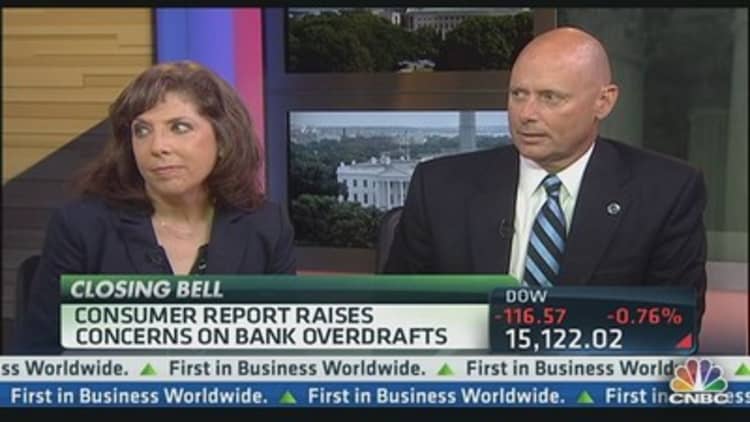Checking accounts—and the debit cards that come with them—should be a simple and straightforward way to handle routine financial transactions. And yet, many people simply don't understand the overdraft policies at their bank or credit union.
A majority of the bank customers (52 percent) who paid a debit card overdraft penalty fee in the last year, did not recall signing up for this service and were not aware that a fee was involved, according to a recent survey by the Pew Charitable Trusts.
Why all the confusion? Is it something the banks are doing?
Four nonprofit organizations teamed up to find out. The California Reinvestment Coalition of Oakland, New Economy Project of N.Y., Reinvestment Partners of Durham, N.C. and Woodstock Institute of Chicago, sent secret shoppers into dozens of bank branches in their cities.
Those mystery shoppers, who made a total of 64 visits, received information that was often "unclear and incorrect," according to a recently released report.
"There wasn't a single bank in which every one of our secret shoppers came back with the same understanding of how their overdraft protection policies worked," said Courtney Eccles, policy director at the Woodstock Institute.
"No one understands overdraft, not even the bankers," said Andrea Luquetta with the California Reinvestment Coalition. "Many of our testers got lengthy explanations that were confusing and sometimes conflicted with the written materials they received."
Read MoreConsumers complain most about these 10 things
Keep in mind: These testers were trained about what to say and what to look for in the responses from bank employees.
"They were significantly more informed than the average consumer looking to open a checking account," said Liz Fusco, staff attorney with the New Economy Project. "If they were confused, I really don't know who wouldn't be."
A complicated service
To understand the problem, you need to understand the rules for overdraft. At most banks and credit unions, checking account customers are automatically enrolled in overdraft protection for paper checks. Bounce a check and you pay a fee.
If you want overdraft protection for debit card transactions and ATM withdrawals, you have to specifically sign up for it. You cannot be automatically enrolled. Financial institutions are required to get your written permission.
Choose to accept overdraft protection and a debit card purchase or cash withdrawal at an ATM will be approved—even if you don't have enough money in your account, but you'll pay a fee for this short-term loan. Right now the median overdraft fee is $34, according to a new report from the Consumer Financial Protection Bureau.

If you do not opt-in for overdraft protection and there isn't enough money in your checking account, the transaction will be declined. In that case, there's no fee and no penalty, but you leave without the goods or money you wanted.
When asked, 68 percent of the bank customers who had experienced a debit card overdraft in the last year told Pew researchers that's what they'd prefer happen in these situations—no sale or cash and no overdraft fee.
The American Bankers Association (ABA) says if there's a problem, financial institutions are not to blame.
"No one in America has debit card and ATM overdraft protection today who did not affirmatively opt in after receiving a one-page, consumer-tested summary of the service and fees," the ABA's senior vice president Nessa Feddis told CNBC. "They receive written verification of their choice as well as multiple reminders when they overdraw, including a summary of fees paid that month and year-to-date in a specially highlighted box on their statement. They can opt out at any time."
Some suggest that the form used to opt-in for overdraft protection is part of the problem. Susan Weinstock, who directs Pew's Consumer Banking Project, calls it confusing.
Read MoreFeds crack down on debt collection 'factory'
It looks like you have to sign it, but you don't," Weinstock said. "If you do sign it, you've signed up for overdraft and you could get hit with an overdraft fee for using your debit card at the store or cash machine."
Consumer advocates would like to see better training and better disclosures from the bankers, to ensure that customers understand their rights and how overdraft works for checks, debit cards and ATM transactions.
"Overdraft protection is a misnomer for a service that's both expensive and hard to understand, particularly if you're paying $35 for a $10 overdraw," said Peter Skillern, executive director of Reinvestment Partners. "The terminology itself is misleading from the get-go."
The four groups that released this report praised Bank of America for deciding not to allow overdrafts on debit cards when used at the point of sale.
If you're not sure what you've signed up for, contact your bank. Since terms can be confusing, ask this specific question: What happens if I use my debit card and there's not enough money in my checking account to cover it? Will the sale be declined or will it be accepted and I get charged an overdraft fee?
—By CNBC contributor Herb Weisbaum. Follow him on Facebook and Twitter @TheConsumerman or visit The ConsumerMan website.

